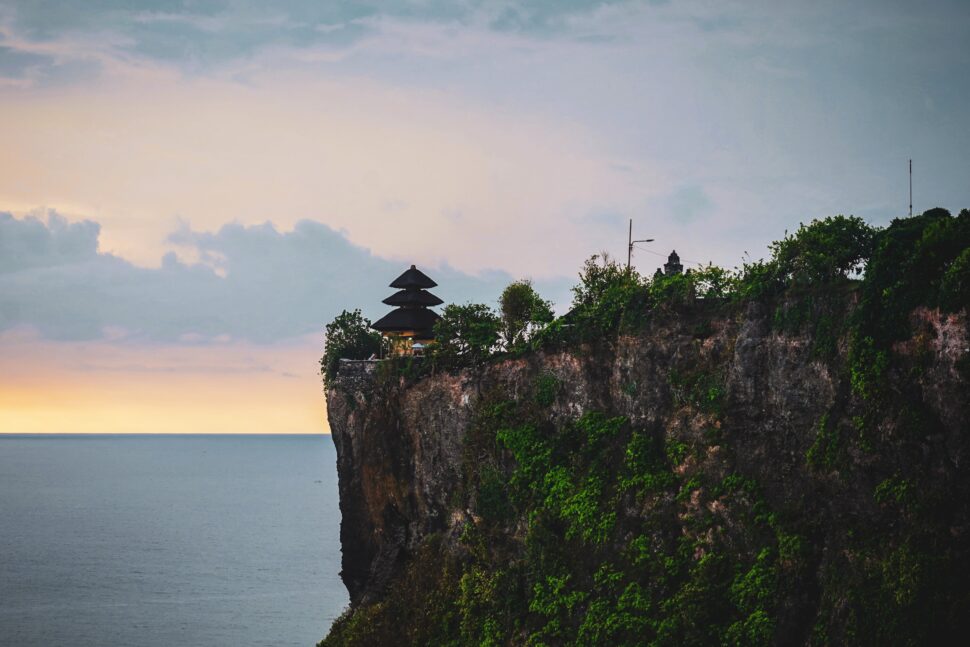Uluwatu Temple History Based On Legends And Archeological Discoveries
How is the Uluwatu Temple History? If Bali is your favorite tourist destination, the name Pura Uluwatu or Uluwatu Temple should be a familiar name to hear. The beautiful temple is one of the sacred worship places for Hindu people in Bali.

Well, if locals come there for prayer, tourists love it for the unique architecture and stunning background scenery. Yes, the temple is located on the top of the cliff. Next to the cliff, there is the Indian Ocean where you can watch the scenic sunset.
More than that, there is a unique tradition in Uluwatu Temple. While waiting for sunrise, you can enjoy the Kecak Dance show. Sure, there is a historical background behind the temple and why the dance is performed there. So, here is the Uluwatu Temple History you should know better.
Geographically, the Uluwatu Temple was located in the District Pecatu, South Kuta, Badung Regency. The cliff where the temple was built is a type of limestone with a height of 97 meters. To reach the temple’s area you must pass through numerous stairs. It is tiring for sure but there is nothing to regret when you have been on the top.
The History of Uluwatu Temple
Based on the inscription discovered by archeologists, the Uluwatu temple was founded by Mpu Kunturan. He was a monk from the Kingdom of Majapahit who also established some other worship temples in Bali including the Sakenan Temple.
The establishments of Uluwatu and many other temples in Bali were predicted to occur around 1000 years ago based on the carbon test. It was also supported by a research result conducted by Indian archeologists. Yes, the research found that in the area of Java and Bali, the stones of the temples were made around the 10 th century.
Aside from Mpu Kunturan, a popular religious figure related to the Uluwatu Temple was Dhang Hyang Dwijendra. He chose Uluwatu as the last place for his spiritual journey. His choice is related to the belief of the Hindu people. They believe that the peak of a spiritual journey was when someone was struck by lightning and completely gone. That’s why the Uluwatu Temple was made on the top of the cliff.
Although the temple was first made and designed by Mpu Kunturan, there is also a story saying that Dhang Hyang Dwijendra was the architect of the temple. Some people around the temple thought that Dhang Hyang was the architect of the renovation of the temple.
In the past, the Uluwatu Temple was not accessible to tourists and common people. The management of the temple started to be more open in 1983 when some parts of the temple were public. Then, in 1999, some parts of the temple were damaged by lightning strikes. The temple was renovated without lessening the essence and value of religious principles.
Another Historical View of the Uluwatu Temple
There are some versions of the history of the Uluwatu Temple. The most conventional version is what you have read in the previous point. However, there are some other historical views about the establishment of the temple.
Some archeologists along with local people believe that the temple was established far before the coming of Mpu Kunturan. There were temples located in the front yard of the main temple with a more ancient design.
Unfortunately, there was no inscription or written note to support the theory even more. The carbon test to check the theory’s validity also has not been conducted. If the second view was true, it means that Mpu Kunturan just continued or completed the temple’s establishment. The temple, in general, was made more than 1000 years ago.
The History of Kecak Dance in Uluwatu Temple
The history of the Kecak Dance Show in the Uluwatu Temple is not different from the same show in other places in Bali. In 1930, a local artist, Wayan Limbak collaborated with a German painter, Walter Spies to create the Kecak Dance. The Kecak Dance by Limbak and Walter was generated from a Balinese traditional ritual.
To maintain the ritual as well as to introduce it in the form of arts for people outside Bali, the New Kecak Dance was re-choreographed. They added the story of Ramayana in the Hindu view to make it look more attractive.
People who live around the Uluwatu Temple found the value suggested by the Kecak Dance equaled the ritual in the temple. That’s reasonable since the dance and ritual were made from the same source, it is Hindu teaching.
Along with the increase of tourists visiting the temple, some local people initiated the Kecak Dance Show at particular times, especially in the afternoon when the sun almost sets. The Dance movement just beautifies the temple along with the orange sunset background. Until now, Kecak Dance in Uluwatu Temple has become one of the most demanded attractions in Bali.